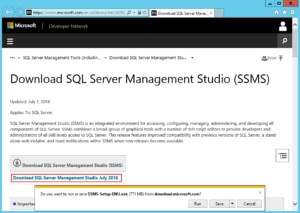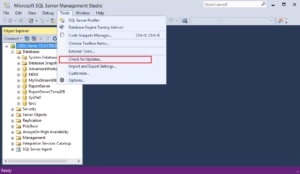With the SQL Server 2016 release Microsoft has changed the way that they are delivering SQL Server Management Studio (SSMS). In previous releases SSMS was installed as a part of the SQL Server installation itself from the SQL Server Installation Center. That is no longer the case with SQL Server 2016. Now SSMS is not installed as a part of the main SQL Server installation process. Instead you need to install SSMS separately. There a number of reasons Microsoft has made this change. First, this allows Microsoft to update SSMS more frequently than they were able to in the past when it was bundled in with the main release. In addition, a best practice for managing SQL Server is to run SSMS from a networked workstation rather than running SSMS directly on the SQL Server system itself. Separating the SSMS installation from the main SQL Server Installation Center makes it easier to install SSMS on a separate systems.
SSMS has a number of core changes compared to earlier versions of SSMS. First, SSMS 2016 is now based on the Visual Studio 2015 Isolated Shell. It includes a wizard for the new Always Encrypted feature and a new quick launch toolbar to quickly find different menu items. SSMS 2016 also includes a new SQL PowerShell module and new cmdlets that work with Always Encrypted, SQL Agent, and SQL Error Logs. There’s also a new activity monitor with filtering and automatic refresh. For a complete list of all of the features in SSMS 2016 you can check out Features in SQL Server Management Studio
Managing Multiple SQL Server Instances with SSMS 2016
The new SSMS 2016 is able to manage multiple different SQL Server releases. SSMS 2016 is able to work with:
- SQL Server 2016
- SQL Server 2014
- SQL Server 2012
- SQL Server 2008 / R2
- SQL Azure
- Azure SQL Data Warehouse
Microsoft states that there is no specific restrictions for using SSMS 2016 with SQL Server 2000 or SQL Server 2005 but all of the features may not work properly.
Running the SSMS Install
To install SSMS 2016 you first need to download it. You can get SSMS for SQL Server 2016 at Download SQL Server Management Studio (SSMS) or you can begin the SSMS 2016 download using the installation link for SSMS on the SQL Server 2016 Installation Center in Figure 1.
Figure 1 – The link to install SQL Server Management Studio
Clicking the Install SQL Server Management Tools link opens up the Download SQL Server Management Studio page that you can see in Figure 2.
Figure 2 – The SQL Server Management Studio Download Page
Clicking the Download SQL Server Management Studio July 2016 link will prompt you to Run or Save the SSMS-Setup-ENU.exe program that you can see in Figure 2. If you choose the Save option the SSMS-Setup-ENU.exe setup program will be saved to your Downloads folder. Then you can click Run after the download completes to display the SSMS 2016 installation screen that you can see in Figure 3.
Figure 3 – The SQL Server Management Studio Installation Program
Clicking Install will launch the SSMS 2016 setup process. The setup takes several minutes as it installs the .NET Framework 4.6.1 and the Visual Studio 2015 isolated shell as part of the SSMS 2016 setup. The system required a restart following the SSMS 2016 installation. The SSMS setup logs are stored in the %USERPROFILE%\AppData\Local \temp\SsmsSetup directory. The logs can be used for troubleshooting if you encounter errors during the installation process.
Unlike earlier versions SSMS 2016 automatically checks online for updates. You can also manually check for updates using the Check for Updates option on the Tools menu. You can see SSMS 2016 in Figure 4.
Figure 4 –SQL Server Management Studio 2016





I’m currently using SQL Server 10.0 Management Studio and want to install Management 2016 Studio. When I install 2016, will it overwrite my old version or install as a totally new stand-a-lone application?
And yes, we are installing new SQL Server 2016
What is the process to copy SQL server 2008 data to a new box that contains SQL Server 2016?